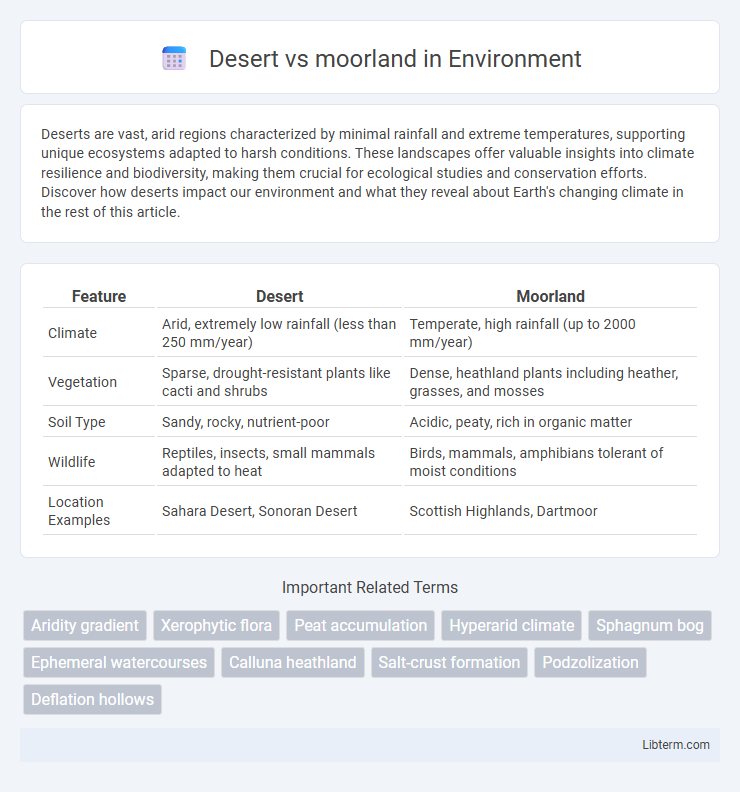Deserts are vast, arid regions characterized by minimal rainfall and extreme temperatures, supporting unique ecosystems adapted to harsh conditions. These landscapes offer valuable insights into climate resilience and biodiversity, making them crucial for ecological studies and conservation efforts. Discover how deserts impact our environment and what they reveal about Earth's changing climate in the rest of this article.
Table of Comparison
| Feature | Desert | Moorland |
|---|---|---|
| Climate | Arid, extremely low rainfall (less than 250 mm/year) | Temperate, high rainfall (up to 2000 mm/year) |
| Vegetation | Sparse, drought-resistant plants like cacti and shrubs | Dense, heathland plants including heather, grasses, and mosses |
| Soil Type | Sandy, rocky, nutrient-poor | Acidic, peaty, rich in organic matter |
| Wildlife | Reptiles, insects, small mammals adapted to heat | Birds, mammals, amphibians tolerant of moist conditions |
| Location Examples | Sahara Desert, Sonoran Desert | Scottish Highlands, Dartmoor |
Defining Deserts and Moorlands
Deserts are arid regions characterized by extremely low precipitation, sparse vegetation, and extreme temperature variations, often exceeding 250 mm of annual rainfall. Moorlands are upland areas dominated by acidic soils, peat, and heathland vegetation, typically receiving high rainfall and experiencing cooler climates. The distinct ecological conditions and soil compositions define the contrasting environments of deserts and moorlands.
Key Climate Differences
Deserts exhibit extremely arid conditions with annual precipitation often below 250 millimeters, characterized by hot days and cold nights due to minimal cloud cover. Moorlands maintain higher moisture levels with regular rainfall, typically between 600 to 1,000 millimeters annually, supporting acidic, peat-rich soils and cooler, more stable temperatures. The stark contrast in precipitation and temperature variability defines the key climate differences between these two ecosystems.
Soil Composition and Characteristics
Desert soils, known as aridisols, are typically sandy, low in organic matter, and exhibit high salinity with poor water retention due to minimal rainfall and sparse vegetation. Moorland soils, classified as podzols or peaty soils, contain higher organic content with acidic pH levels, resulting from extensive decomposition of plant material and abundant moisture conditions. These soil differences influence vegetation types, with deserts supporting xerophytic plants adapted to nutrient-poor, dry soils, while moorlands sustain heathland species thriving in nutrient-poor, acidic, and moist environments.
Flora: Plant Adaptations in Deserts vs Moorlands
Desert flora exhibits xerophytic adaptations such as thick cuticles, deep root systems, and water-storing tissues to survive extreme aridity. Moorland plants, including heathers and sedges, are adapted to acidic, nutrient-poor soils with shallow roots and tolerance to waterlogged conditions. Both ecosystems demonstrate specialized plant strategies that optimize survival in harsh environmental conditions.
Fauna: Animal Life and Survival Strategies
Desert fauna includes species like camels, fennec foxes, and sidewinder snakes, which have adapted to extreme heat and scarce water by developing nocturnal habits, water retention mechanisms, and burrowing behaviors. Moorland fauna, such as red grouse, mountain hares, and adders, survive in cooler, wetter environments by utilizing thick fur, seasonal camouflage, and diets based on heather and grasses. Both ecosystems exhibit unique survival strategies tailored to their specific climates and resource availability, reflecting evolutionary adaptations to arid deserts and nutrient-poor, acidic soils of moorlands.
Water Availability and Distribution
Deserts exhibit extremely low water availability, with annual precipitation often below 250 millimeters, leading to sparse vegetation and extensive arid landscapes. Moorlands receive significantly more rainfall, typically ranging from 500 to 1500 millimeters annually, supporting peat formation and dense, water-retentive soils. Water distribution in deserts is highly uneven, resulting in ephemeral streams and isolated oases, whereas moorlands maintain consistent moisture through saturated soils and frequent fog or mist inputs.
Human Habitation and Livelihoods
Deserts, characterized by extreme aridity and sparse vegetation, support limited human habitation primarily through nomadic pastoralism, mining, and oasis agriculture, relying on scarce water resources. Moorlands, with their acidic soils and wetter climates, have historically sustained communities engaged in sheep grazing, peat harvesting, and small-scale farming adapted to nutrient-poor conditions. Both environments require specialized livelihood strategies that emphasize resource conservation and adaptation to challenging ecological constraints.
Biodiversity Comparison
Deserts exhibit low biodiversity with specialized flora and fauna adapted to extreme arid conditions, including cacti, succulents, reptiles, and nocturnal mammals. Moorlands support higher biodiversity with acidic, nutrient-poor soils hosting heather, grasses, and a variety of insects, birds such as grouse, and small mammals. The structural complexity and moisture availability in moorlands create more niches, resulting in richer species diversity compared to the sparse life found in desert ecosystems.
Environmental Challenges and Conservation
Deserts face extreme water scarcity and high temperatures, leading to fragile ecosystems vulnerable to soil erosion and habitat loss, while moorlands are threatened by drainage, peat extraction, and overgrazing, which disrupt carbon storage and biodiversity. Conservation efforts in deserts emphasize sustainable water management and habitat restoration, whereas moorland conservation focuses on re-wetting peatlands and controlling grazing pressure to preserve unique flora and fauna. Both environments require tailored strategies to mitigate climate change impacts and maintain ecological balance.
Tourism and Cultural Significance
Deserts attract tourists seeking unique landscapes, extreme adventure activities, and cultural experiences related to indigenous nomadic tribes, while moorlands offer opportunities for hiking, birdwatching, and exploring ancient heritage sites such as stone circles and historic ruins. Desert tourism often emphasizes vast sand dunes, oases, and desert festivals, while moorland tourism highlights biodiversity hotspots and traditional sheep farming communities. Both landscapes hold deep cultural significance, representing resilience and adaptation in harsh environments, with moorlands often associated with folklore and desert regions linked to ancient trade routes and spiritual practices.
Desert Infographic

 libterm.com
libterm.com